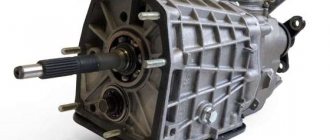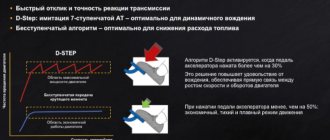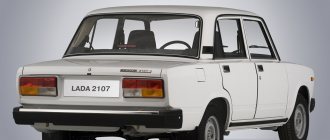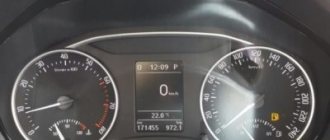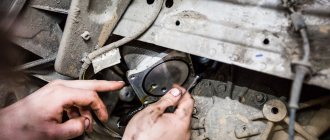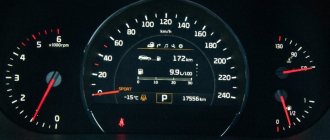DSG-6 is a six-speed robotic gearbox, which contains the principles of operation of a manual and automatic transmission. This gearbox is installed on Volkswagen cars, and its main advantage is smooth gear shifting, and at the moment of switching the power flow is not lost and fuel consumption does not increase compared to conventional automatic transmissions.
Of course, such ideal operation of the gearbox is only possible with timely maintenance and normal operation. It is important to use special consumables, namely original oil and filter. In addition, the article discusses the rules for safe operation of the DSG-6 in order to increase the oil change interval and how much to fill it in different conditions.
The most popular articles on the site:
- How often should you change engine oil?
- Oil 5w30 and 5w40 what is the difference
- What oil to pour into the engine in winter and summer
- How long does it take to change the automatic transmission oil?
When to change the oil: advice from Russian car enthusiasts
Timely oil changes in the DSG gearbox guarantee long and uninterrupted operation of the transmission throughout the entire operation of the vehicle. Regular replacement is essential for the harsh Russian conditions, characterized by poor roads and variable climate. You can also add to this the frequent traffic jams in the central part of the city.
Of course, in such conditions, the oil change interval should be the minimum, namely 40 thousand km. As for the factory 60 thousand, such regulations are relevant for completely ideal conditions, which, as a rule, do not exist in any country. After all, driving style and a number of other factors, including the behavior of other road users, are also important.
How the DSG 6 robotic gearbox works
The box in question is one of the so-called “robots”. In the DSG family of gearboxes, the process of changing the gear ratio is automated, but the box is based on the same classic “mechanics”, supplemented by control units and hydraulic servos. The gearbox gears are switched by synchronizer clutches, but the clutches are driven hydraulically. An electronic unit called “Mechatronic” controls the coordinated operation of the ensemble of box components.
This is what the block looks like when the box is disassembled:
The box unit reads the readings of many sensors:
- rotation speed of the input and output shafts of the DSG box;
- oil pressure in the box and its temperature;
- shift fork positions, etc.
Analyzing this data, the electronics decides to select the desired gearbox mode.
How to drive to extend the life of the DSG-6 and extend the oil change interval
Start without sharply pressing the gas
At the same time, the DSG is certainly a very nimble gearbox, suitable for dynamic driving, but it does not tolerate sharp starts well. The fact is that when you press the accelerator sharply, the electronics of the DSG box closes the two clutches too sharply, which reduces their service life. To increase the resource, you must first release the brake and give the box a second to close the clutch, and then pedal as needed. Of course, this driving mode is not ideal for street and traffic light racing, but this is the only way to extend the clutch life. In addition, a small second’s hesitation before the start can be compensated for by a soft and quick gear change without losing the power of the supercharged engine
Using special modes
Driving with Sport or Manual mode engaged is a way out of the tricky situation in slow-moving traffic, which is the biggest problem for the DSG. To save fuel, the “smart” electronics switches on second gear immediately after the start, but in a traffic jam you have to slow down again, and then the gearbox goes back to first, and at the start again to second - and so on every time. Such operation of the transmission negatively affects the smoothness of operation and reduces the resource of the gearbox itself.
To solve the problem, you need to prevent the DSG from going into second gear at the start. This is exactly why you can use the sports or manual mode, which have a slightly different gear shift algorithm. In this mode, the transmission no longer tries to immediately switch to second at the start and remains in first gear longer. This algorithm will provide a more comfortable ride in traffic jams, and will also reduce the load on the DSG and thereby increase the oil change interval
Braking
Pressing the brake pedal even harder is a rather strange recommendation for a classic automatic, but for the DSG such aggressive braking will only be beneficial. The fact is that pressing the brake really allows you to extend the life of the robotic gearbox.
If for a conventional automatic transmission, lightly pressing the left pedal (not all the way) allows you to control sluggish speed in city traffic jams without risking the resource of the box, then for a DSG such a driving mode can negatively affect reliability. This is due to the fact that due to weak pressure on the brake, the clutch discs do not seem to have time to open and slip, which causes their excessive wear. And if you press hard, the electronics will immediately understand that it is necessary to open the disks, and then slipping can be avoided. Over time, you can get used to working the pedal in such a way that you don’t have to repair the DSG ahead of time.
Shifting to Neutral
The rule “do not switch to position N again” also allows you to extend the life of the oil and gearbox. At the very least, the neutral mode should not be turned on at traffic lights and in traffic jams in order to protect the clutch (it is open when the brake is depressed) and the mechatronics, which will last much longer
Overload
Do not overload the car, as the DSG is prone to severe overheating due to severe overloads. In this regard, the weakest robot is the DQ200, which does not have oil cooling. However, the 6-speed DQ250 with a wet clutch can also be scorched under load. Overheating of the transmission occurs, as a rule, as a result of wheel slipping, sudden starts on steep climbs and towing heavy trailers. Of course, no one forbids loading the car to capacity. It’s just important to remember that such actions may eventually lead to a major overhaul of the box.
Using the handbrake
The more often you use the handbrake, the less harm it will do to the robotic transmission. Modern "racing" drivers have probably long forgotten about the presence of a handbrake, which can be extremely useful for a car with a DSG. It is clear that in a parking lot on a slope, a car with DSG and “parking” turned on will roll in one out of ten cases.
Another thing is important here - parking in the “parking lot” puts a lot of stress on the robot, and such a load can cause the lock in the box to break. The official documentation specifically talks about using the handbrake, which must be turned on before the DSG is put into “parking”. Thanks to this, the box will not rest against the blocker, and you can completely forget about “one in ten cases of rollback”
Basic box malfunctions
Subject to proper operating rules, the DSG 6 gearbox is quite reliable, has a long mileage and fine-tuning capabilities. But the design features also caused some problems with the box.
Friction clutch wear
Most often, the “disease” is manifested by jerking of the gearbox when engaging even-numbered gears or when reverse gear disappears. At the same time, the box goes into emergency mode, prohibiting gear changes, and information about errors enters the automatic transmission unit.
In this case, there is only one repair method - either replacing the entire clutch or individual friction discs (if the car's mileage is up to 150 thousand km). If the entire clutch was replaced on a DSG 6, the box must be adjusted using a proprietary diagnostic device; it is also advisable to adapt the DSG 6 clutch while in motion. Adaptation is also required when replacing disks.
Wear of control solenoids in the mechatronics unit
Another typical problem with these boxes, which manifests itself as “kicks” of the automatic transmission. In this case, the DSG gearbox does not go into emergency mode, and there are no errors in the memory either. The problem can be resolved by replacing the mechatronics or broken solenoids.
Oil change: how much and what to fill
To partially change the oil in the DSG-6 gearbox, you need 6 liters of original VAG fluid G052182A2.
In addition, when servicing the box, you will also need a new O-ring for the drain plug. Its original port number is 91084501.
As for the oil filter, its catalog number must correspond to the VAG marking 02E305051C.
What other oil can I use?
If they want to save money, many owners of Volkswagen cars prefer similar lubricants, which are no worse in quality than the original fluid. To choose a suitable analogue, you need to pay attention to compliance with the original tolerances. For example, one of the best options is Pentosin FFL-2 - this is a specialized oil for robotic transmissions.
Oil in DSG-6: mixing or using analogues for conventional automatic transmissions
Mixing is permitted if both oils are identical in their properties and specifications. If you plan to use another oil for topping up, then you must first remove the old fluid from the box, and only then fill in another oil. This will be the safest option.
Motorists are also interested in the question regarding the compatibility of conventional automatic transmission oil with a DSG gearbox. We are talking about universal lubricants such as Motul Multi ATF or Castrol ATF. Considering the ATF prefix, it is not difficult to guess that such oils are recommended only for classic automatic machines, and they cannot be poured into a robot.
How much oil is in dq250?
Oil change
and oil filter in DSG6 is recommended to be carried out every 60,000 km.
For a partial replacement, 5 liters of oil
(02E305051C) are required, as well as an oil filter, a seal for the oil filter housing and a seal for the drain plug.
Interesting materials:
How to make a combo box in access? How to make form fields in Word? How to make table margins in Word? How to make full screen mode on Samsung TV? How to make a perfect square? How to hard reset AirPods? How to make a stripe at the bottom of the MIUI 12 screen? How to make a translucent background in Corel? How to make translucent text on a video? How to set one and a half spacing between paragraphs?
Why does DSG-6 require more oil than DSG-7?
The DSG-6 transmission is designated DQ-250 and belongs to the previous generation of the more modern 7-speed DQ-200. Both transmissions have significant design differences, due to which much more oil has to be poured into the six-speed robot than in the DSG-7.
This is due to the oil bath in which the clutch unit of the DSG-6 box is immersed. Therefore, the 6-speed gearbox is called “wet”, while the DSG-7 has a “dry” clutch (without an oil bath). This may explain the differences in the required oil volume, which for the DSG-6 is 6-6.5 liters. At the same time, DSG-7 requires only 2 liters - the same amount as is usually poured into a manual transmission.
DSG pros and cons
Both developers and drivers using these boxes note a number of positive aspects:
- reduced fuel consumption (according to some statements, up to 20% compared to traditional
- manual transmission
- smooth movement;
- reducing the time required for acceleration;
- ease of control of the box.
As in an automatic transmission, there is no clutch pedal, and the gearbox selector is familiar to anyone who has encountered an automatic transmission.
But there are also disadvantages. The most important of them is the price: a car equipped with a DSG unit costs more than its peers in its class and model range. In addition, it is not always possible to avoid the “thoughtiness” of the box: the DSG sometimes does not keep up with the acceleration dynamics of the vehicle, and switching occurs with some delay. The electronic unit of the box, according to reviews, is another weak point: the DSG 6 mechatronics periodically fails and requires maintenance or replacement. And drivers note increased heating of the box due to the constantly active preselector.
Routine maintenance of the gearbox will also cost a little more: for replacement you will need from 6 to 6.5 liters of special gear oil. DSG-7, for example, due to the use of “dry” technology, consumes less liquid, about 2.5 liters.
In general, the design of the box is less repairable compared to “mechanics”, and in some cases the entire box will have to be replaced. But with proper service, the DSG 6 has a stated service life of up to 250 thousand km.
When not to change the oil filter
- After replacing the oil cooler of the box and the sealing rings, the filter does not need to be changed unless coolant gets into the oil
- There is no need to replace the filter if you replace the shift shaft O-ring
- When replacing the sealing ring for a flange or rigid shaft, the oil filter also does not need to be changed.
- There is also no need to replace the filter if you need to replace a leaking mechatronics cover, oil pump or dual clutch.
Which cars are equipped with DSG-6
DSG-6 – gear mechanics with automatic gear change. The first version of this gearbox with a wet clutch was introduced in 2003. BorgWarner participated in the development, commissioned by Volkswagen. After successful testing, VAG decided to install this box on its popular front-wheel drive cars.
Volkswagen
- Passat B6 2.0 TDI 140 l. With.
- Passat B6 TSI 2.0 211 l. With.
- Passat B6 TSI 1.8 152 l. With.
- Golf Mk5 TDI 1.9 105 l. With.
- Jetta 5 TDI 1.8 150 l. With.
- Touran 1T TDI 2.0 170 l. With.
- Tiguan MK2 TSI 2.0 170 l. With.
- Sharan 7N1 TDI 2.0 170 l. With.
- Scirocco Mk3 TDI 2.0 170 l. With.
Audi
- A3 8P TFSI 1.4 125 l. With.
- A3 8P TFSI 1.8 160 l. With.
- A3 8P TFSI 2.0 200 l. With.
- A3 8P TDI 2.0 170 l. With.
- A3 8P TFSI 3.2 250 l. With.
- A3/Q3 8U TFSI 1.4 150 l. With.
- TT 8J TFSI 1.8 170 l. With.
- TT 8J TDI 2.0 211 l. With.
Skoda
- Superb 3T TDI 2.0 140 l. With.
- Superb 3T TSI 2.0 200 l. With.
- Yeti 5L TSI 1.8 200 l. With.
- Yeti 5L TDI 2.0 170 l. With.
- Octavia A5 TSI 1.4 250 l. With.
- Octavia A5 TSI 1.8 150 l. With.
- Octavia A5 TDI 2.0 170 l. With.
- Kodiaq TSI 1.4 170 l. With.
Seat
- Leon TFSI 2.0 270 l. With.
- Toledo TDI 2.0 140 l. With.
- Altea TFSI 2.0 200 l. With.
- Alhambra TDI 2.0 170 l. With.

